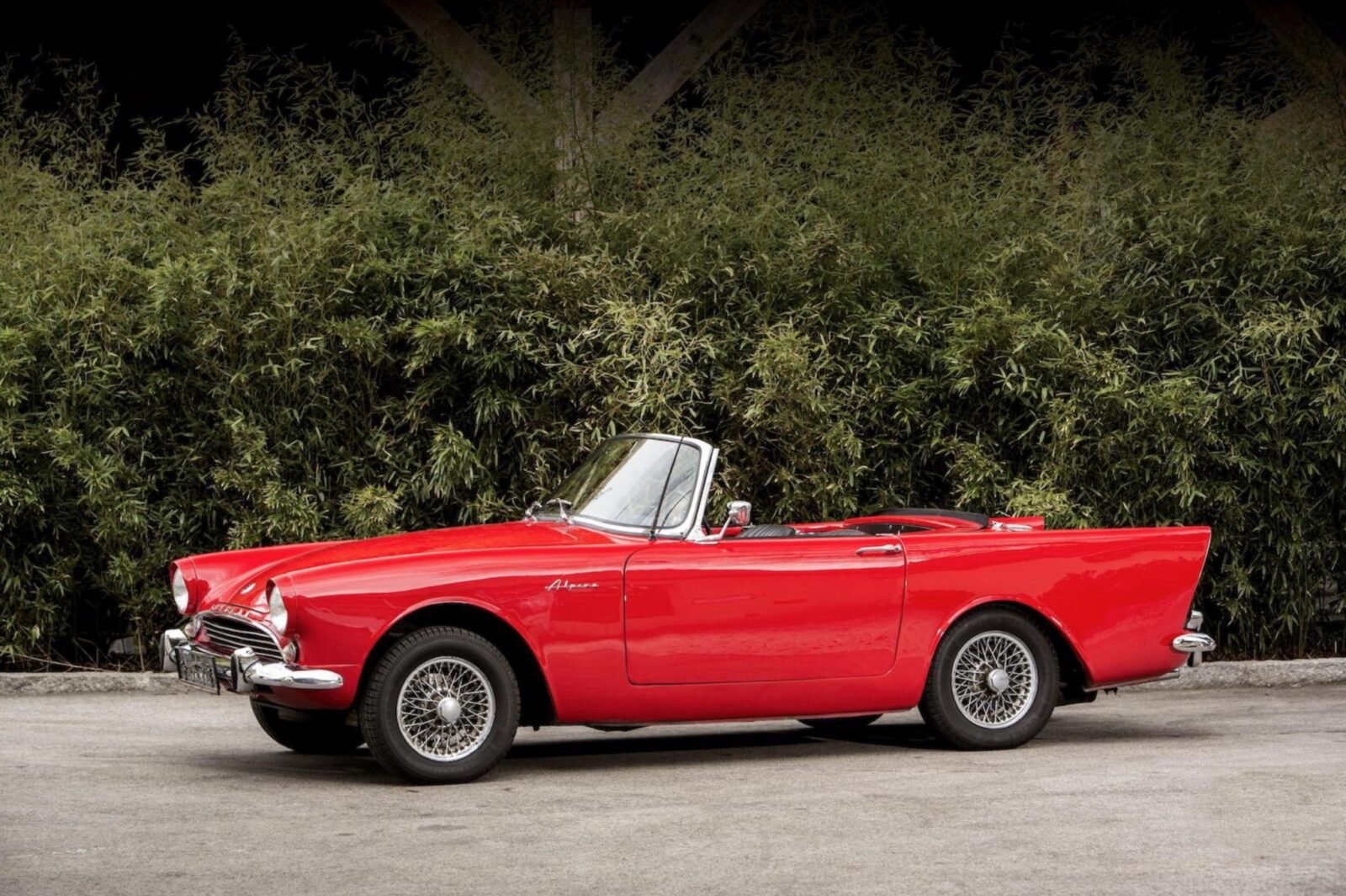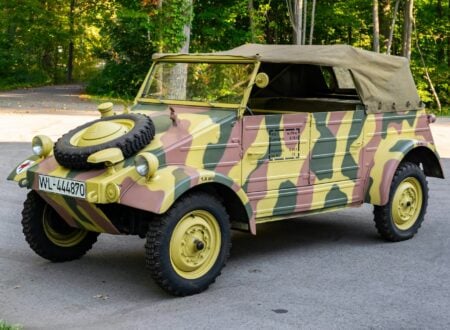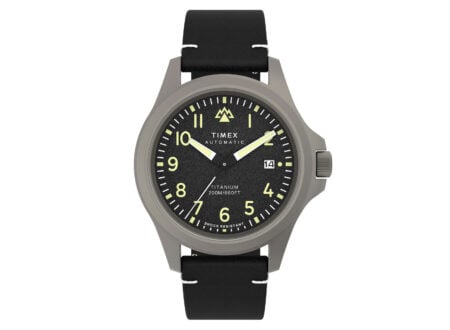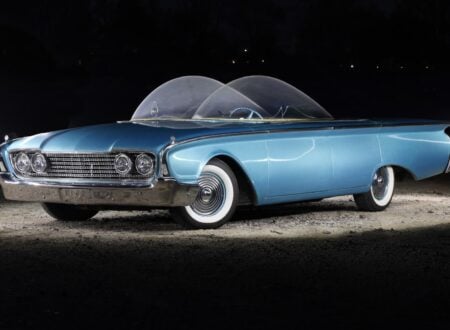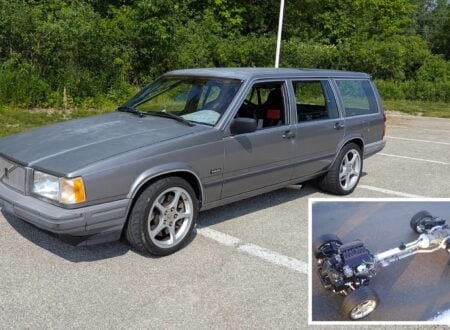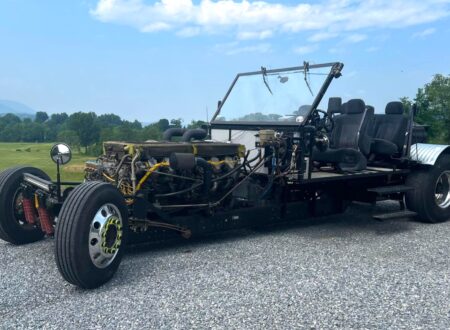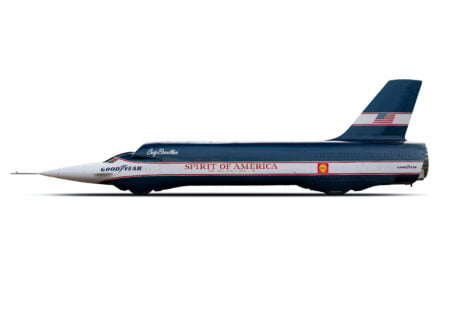The Sunbeam Alpine
Introduction
The Sunbeam Alpine name was first used on a car that pre-dates the car most of us think of when the name Sunbeam Alpine is mentioned. The first Sunbeam Alpine Marks I and III (1953-1955) were two seater roadsters based on the Sunbeam-Talbot 90 saloon and which were created specifically for competition with the likes of Sir Stirling Moss at the helm. That old model Sunbeam Alpine was also driven by American Actress Grace Kelly in the 1955 movie “To Catch a Thief”. But the Sunbeam Alpine that we are interested in is the model that came after it, the model that starred as one of the first ever James Bond cars in the movie “Dr. No” in 1962 with Sean Connery behind the wheel.
The new for 1959 Sunbeam Alpine brought to the world of British sports cars something that the purists over at Austin-Healey, Morgan and MG had not thought so much about; it brought comfort. Here was a British sports car that had wind up windows and a soft top that was actually waterproof. Not content with that it even had a heater that worked! The Sunbeam Alpine was also a departure from what the British would consider to be traditional styling, in fact it was styled by Americans. With its pronounced fins at the rear giving the car an almost wedge shaped appearance the Sunbeam Alpine was an avant garde design to come out of Britain. Built to be ruggedly reliable, sporty, fun, and sufficiently stylish that 007 looked entirely at home in one, this was a car that deserved to be a world beater.
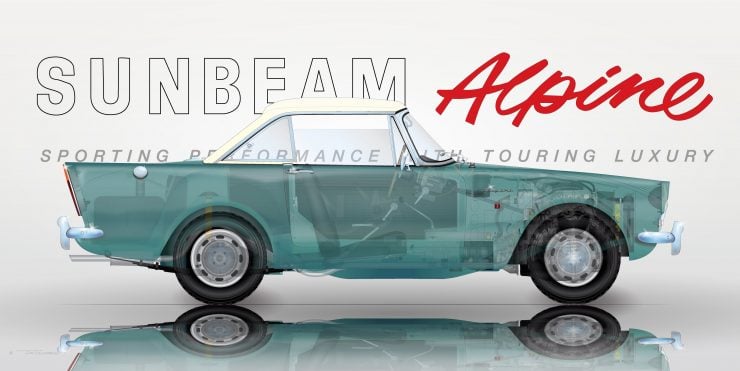
Buy the above poster here at Sports Car Art
History
William and Reginald Rootes who had started the Rootes Group automotive manufacturer found their company left behind when first Jaguar, then Austin and Triumph, came up with viable and popular sports cars that paved the way for those companies to bring in much needed export revenue to British car industry coffers. The success of the Jaguar XK120 and the Austin-Healey 100 spoke for itself but William and Reginald Rootes proceeded cautiously. Perhaps they hoped that their refined and classic Sunbeam Alpine Marks I and III based on the old Sunbeam-Talbot 90 would be sufficient to win a share of the US export market, but it turned out not to be so. The Rootes brothers then decided that the best plan to create a car for the US market would be to get Americans to design it.
The styling work for the Sunbeam Alpine was entrusted to the internationally renowned American industrial design house of Raymond Loewy with the bulk of the design work being done by Ken Howes who had previously worked for Studebaker. Raymond Loewy and Ken Howes had done previous design work for Rootes having been responsible for the very pretty Sunbeam Rapier. The resulting design was a superb blending of the American avant garde with British classic style. The design called for prominent American style fins at the rear of the car which, when contrasted with the car’s low front end gave it an almost wedge shaped style that made it look fast even when standing still on the showroom floor.
The Rootes brothers were practical businessmen and they wanted to develop the new sports car based around a parts inventory they already had. The foundation of the new Sunbeam Alpine was to be the floor-pan of the company’s small three door estate car the Hillman Husky. This floor pan was given an integral under-floor X reinforcement creating a very stiff base for the monocoque body. The running gear was sourced from the Sunbeam Rapier coupé but with the Rapier’s front drum brakes upgraded to 9½” Girling Discs with 9” drum brakes at the rear. The front suspension was fully independent with coil springs and tubular shock absorbers and an anti-roll bar, whilst at the rear was a conventional live axle with semi-elliptic leaf springs and lever shock absorbers.
The engine for the new Sunbeam Alpine was a Rootes 1494cc in-line four cylinder OHV with an alloy cylinder head. This engine was mated to a four speed manual gearbox with synchromesh on the top three gears in typical post war British style.
When the Sunbeam Alpine made its public debut at Cannes on July 2, 1959 its comparatively small 1.5 litre engine got a bit of a mixed reception but it was able to match the performance of the MGA, its nearest rival, and was almost up with the Triumph TR3A. With its lively handling, stylish looks, and comfortable well appointed interior the Sunbeam Alpine was an attractive sports car with sufficient performance.
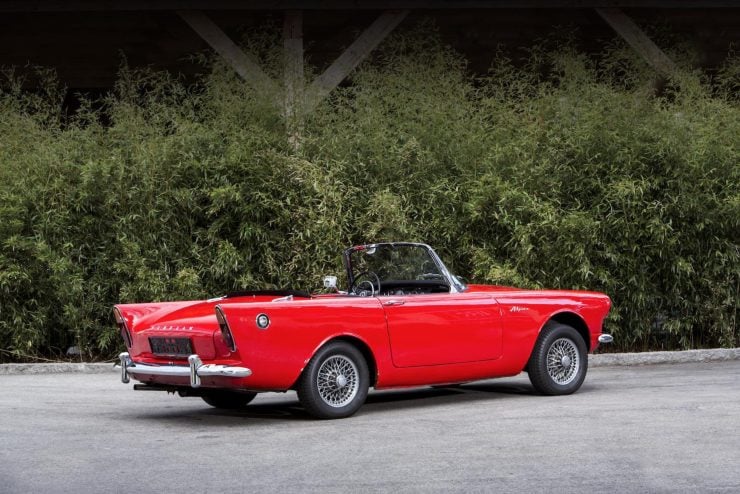
Specifications
Series I (1959-1960)
The Series I Sunbeam Alpine was fitted with the Rootes alloy head, three main bearing OHV 1494cc in-line four cylinder engine breathing through two Zenith 36 WIP2 downdraught carburettors. With its 9.2:1 compression ratio this engine produced 83.5hp at 5,300rpm and 89lbs/ft of torque at 3,400rpm. This engine was mated to a four speed close ratio manual gearbox with synchromesh on the top three gears and had the option of a Laycock de Normanville electric overdrive. Wheels were steel with the option of wire wheels. Top speed on test was recorded at 99.5mph.
There was one notable variant of the Series I Sunbeam Alpine. In 1960 a luxury three door “shooting brake” version was offered which had a leather interior and wood dashboard. The price of this luxury version was approximately double that of the standard roadster and so these cars are scarce.
Series I Sunbeam Alpines have a serial number that begins with “B90”. The Series I cars have some details unique to themselves as follows:
>>> At the leading edge of each door is a three inch high chrome post that serves as a wind up window guide.
>>> The centre console is side opening.
>>> The original steering wheel is of comparatively larger diameter than that of later cars, although the original wheel may have been replaced at some point in the car’s history.
>>> The original pedals are quite small.
>>> The dashboard was originally painted silver grey and there was no map light fitted above the cubby box.
Series II (1960)
The Series II cars were fitted with a larger 1,592cc (97.1cu. in.) in-line four cylinder engine but only fitted with a single Solex carburettor. This engine produced 80bhp and the small drop in power resulted in a slightly lower top speed of 98.6mph.
The Series II cars look almost identical to the Series I but the following details can be used to identify one:
>>> Serial number begins with “B91”
>>> The side window posts were steel and extend to the top of the windscreen.
>>> Smaller original steering wheel.
>>> Wider rear springs
>>> Cant rails as stiffeners for the edge of the convertible soft top around the side windows.
>>> Rain gutter on the inside of the door tops.
In 1961 coach-building company Thomas Harrington Ltd. produced customised fastback versions of the Sunbeam Alpine by cutting away the rear fenders and creating a fibreglass roof and boot or rear hatchback. These were the Harrington Alpine, Harrington Le Mans, and ”C” Series. These cars were more luxuriously appointed with Microcell seats, walnut dashboards, wire wheels, and had engines Stage II factory tuned to produce 103bhp. The Harrington Le Mans coupé cars had the Laycock de Normanville overdrive as standard equipment.
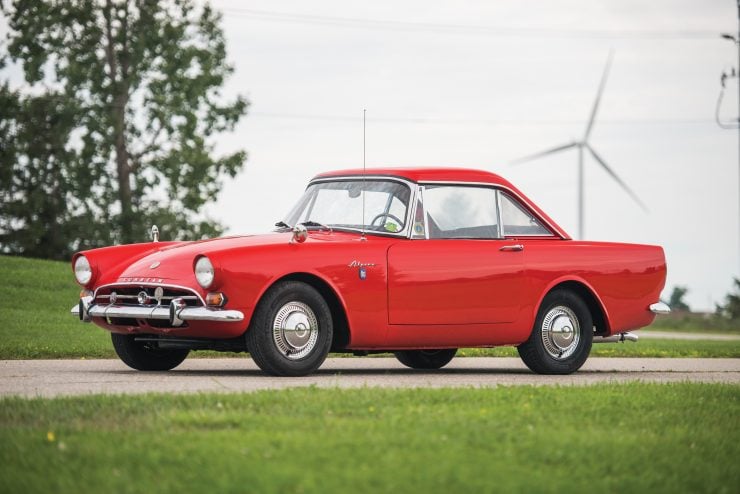
Series III (1963-1964)
The Series III cars retained the 1,592cc (97.1cu. in.) in-line four cylinder engine used in the Series II cars but with Zenith W1A3 carburettors with a single air cleaner and a cast-iron exhaust manifold. Power was 80.3hp and 91lbs/ft of torque. The Series III were made available in both roadster and hard top versions.
Only 5,863 of the Series III cars were made making these cars more scarce and therefore more valuable to collectors.
The Series III cars have the following identifying features:
>>> Serial numbers begin “B92”
>>> Fuel tank split into two interconnected 6.75 gallon tanks mounted in the rear wings. This was done to greatly improve the boot space. The spare tyre is stored vertically and boot space was now 9.25 cubic feet.
>>> Quarter vents added to front of doors. The Series III are the only Sunbeam Alpines to have the original large rear fins with quarter vents on the leading edge of the doors.
>>> Produced in two models; the Gran Tourismo (GT) with fixed hard top, and the Sports Tourer (ST).
>>> New style hard top option.
>>> GT style interior with wood dashboard and wood rimmed steering wheel. Steering column adjustable.
>>> Two speed windscreen wipers.
>>> Adjustable Microcell seats.
>>> Bonnet badge is a chrome boss with plastic insert.
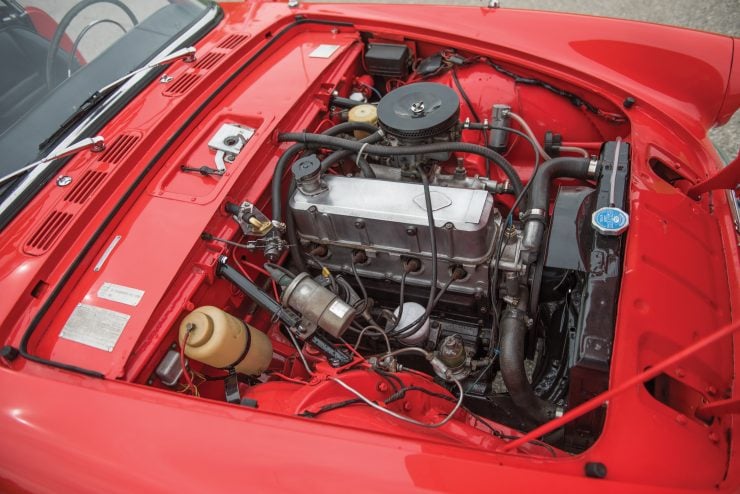
Series IV (1964-1965)
The Series IV cars saw a significant change in styling with the rear fins greatly reduced and the rear of the car given a more squared off look. Engine power was increased slightly to 82bhp. During production a full synchromesh gearbox replaced the older one with no synchromesh on first gear and an automatic transmission was made available as an option with the view to this potentially being popular with US buyers. The automatic turned out not to be popular on either side of the Atlantic. With Chrysler Corporation buying a significant share of the Rootes Group the Sunbeam Alpine became available in US Chrysler dealerships and was thus able to benefit from the Chrysler dealer network support.
The Series IV cars have the following identifying features:
>>> Serial numbers begin “B94”.
>>> Borg Warner Type 35 automatic transmission offered as an option although it was not popular and very few cars were fitted with it. Cars that were originally fitted with the automatic gearbox have the suffix “B.W.” at the end of the serial number.
>>> Rear fins reduced in size and rear of car given a more conservative squared off look.
>>> Front side lights changed to a two bulb type with clear white parking light and amber flashing turn indicator.
>>> New bumper over-riders with rubber tips.
>>> Hinged fuel cap.
>>> Single bar grille with Rootes medallion.
>>> Series IV badge under the “Alpine” on the right side of the boot.
Series IV A variant appears about mid way through the Series IV production. An extra digit is added to the serial number and Series IV A cars begin with serial number B94100000. These cars have a fully synchromesh four speed manual gearbox and were also available with the Borg Warner Type 35 automatic transmission as an option.
From 1964-1967 the Sunbeam Tiger version of the Alpine was made. This car was essentially a Sunbeam Alpine with the four cylinder British engine replaced with a Ford V8 in the same way that the AC Cobra was a British AC Ace with the smaller British engine replaced with a Ford V8. The Sunbeam Tigers were built by Jensen in the UK. Most Sunbeam Tigers were fitted with a 4.3 litre/260 cu.in. Ford V8 although some later cars had the 4.7 litre/289 cu. in. V8. The gearbox was a Ford four speed manual with the drive train suitably built to withstand the much higher power of the V8 engine. The Sunbeam Tiger was the car of secret agent Maxwell Smart in the TV series “Get Smart”.
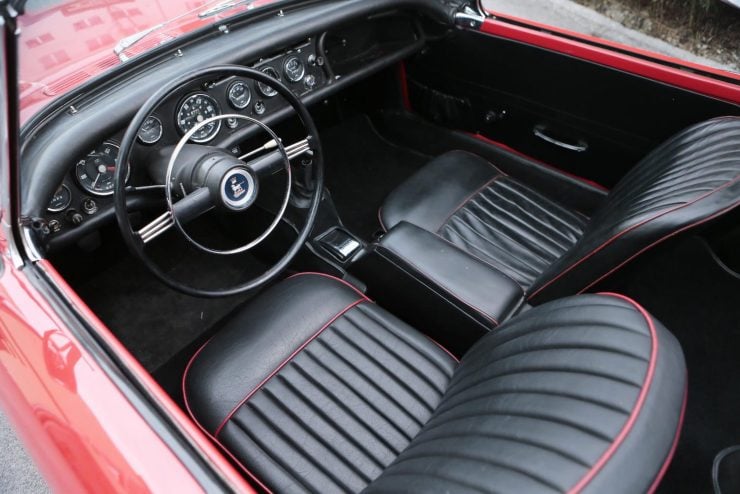
Series V (1965-1968)
The Series V are the last of the Sunbeam Alpines. These cars were fitted with a different 1,725cc/105.3cu. in. five main bearing engine breathing through twin Zenith-Stromberg 150CD semi-downdraught carburettors, and also fitted with a tubular exhaust manifold. This engine produced 93bhp although the power for some markets was up to 99bhp. The unpopular automatic transmission option was dropped. The Series V Sunbeam Alpine with overdrive became a 100mph capable sports car.
The Series V cars have the following identifying features:
>>> The serial number is of nine digits and begins “B395”.
>>> 1,724cc engine breathing through twin Zenith-Stromberg carburettors.
>>> 35amp alternator replaces the generator and the car’s electrical system is now negative earth.
>>> No “Sunbeam” lettering or badge on the bonnet.
>>> Chrysler “Pentistar” logo on the lower front fender with a fender badge “1725”.
>>> Rubber floor mats.
>>> The hard metal cover for the soft top on previous roadster models replaced with a soft vinyl cover that clips in place.
>>> Late Series V cars have non peaked headlight rims and rear license plate lights mounted on the bumper.
>>> Only the ST version exported to the United States market. GT and ST available in other markets.
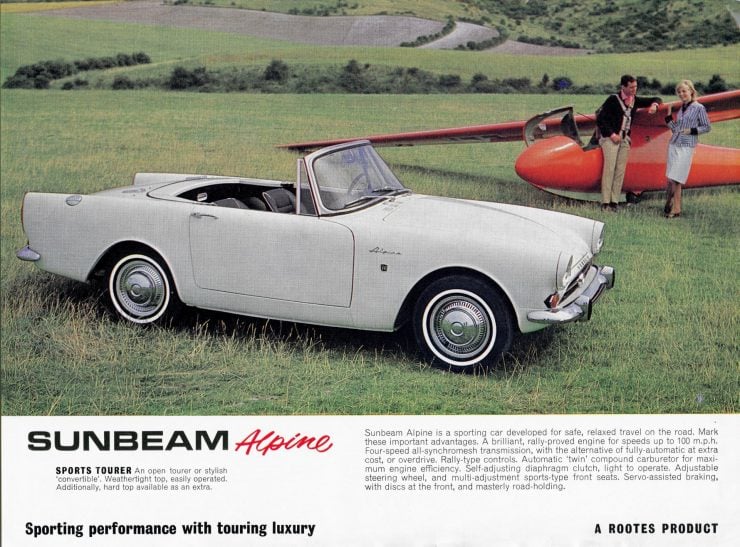
Buying a Sunbeam Alpine
Body and Frame
When buying any old British sports car the bodywork and frame are the mission critical areas for examination and evaluation.
>>> Check for rust in rocker panels and floors. Especially just behind the front wheels where moisture tends to get thrown up and trapped between the front fender and the inner wheel arch.
>>> Check the lower front and rear fenders, door edges, inner rear wheel arches.
>>> Check the rear leaf spring attachment points.
>>> Check the boot floor and the structural rails that end in the boot.
>>> Check door gaps and door function. Jack up the car and check for door function. If problems emerge with door operation with the rear of the car jacked up then this points to serious structural weakness in the frame.
When buying a Sunbeam Alpine it is critical to find one with good sound bodywork. There were far fewer Sunbeam Alpines made than MGB’s for example and so finding replacement body parts is far more difficult than for popular cars as the MGB of which about half a million were made and thus for which almost anything can be found.
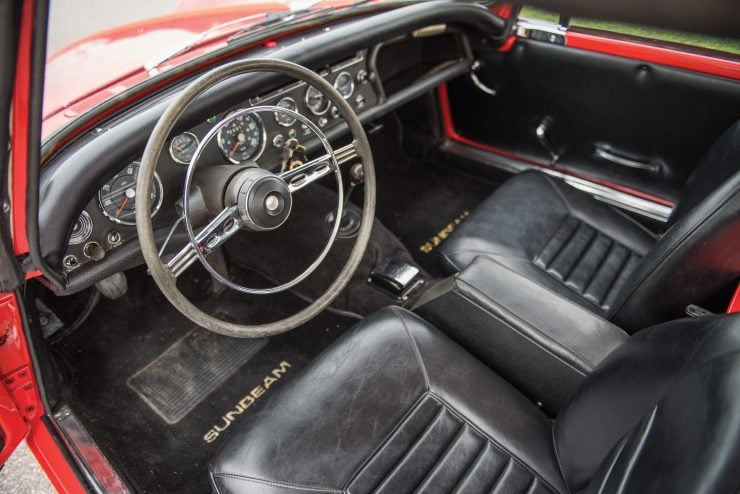
Trim and Interior
Door and window seals can be replaced with newly manufactured ones. Soft tops are currently made. Upholstery and door trims are being made. New complete dashboard panels are available. Steering wheels can be repaired (or replaced). The original instrumentation can be given to a specialist for restoration. Trim and badges can also mostly be obtained although this is easier from Series III cars onwards because they share many common components with the Sunbeam Tiger.
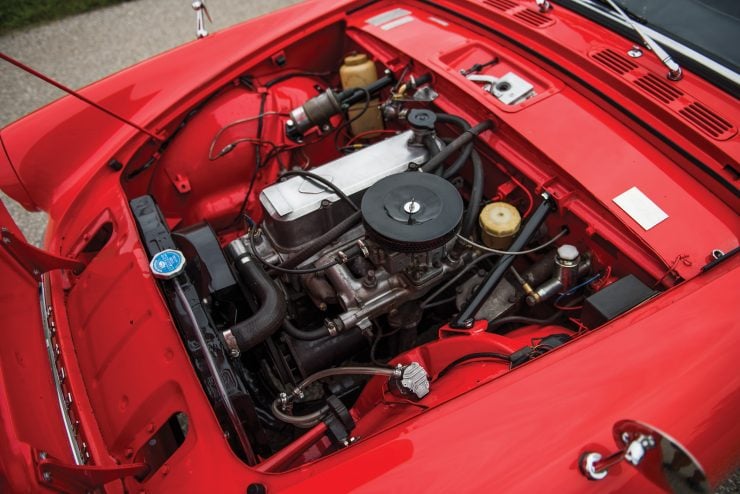
Engines
The four cylinder engines used in the Sunbeam Alpines are all sturdy and very conventional units. The 1,494cc and 1,592cc engines have three main bearing crankshafts whilst the 1,725cc has a five main bearing crankshaft. Evaluating any of these engines is much the same as for any British car of this era:-
>>> Run the engine and listen for noises that indicate issues. Check for blue oil smoke in the exhaust.
>>> Do a cylinder leakage test.
>>> Check the radiator coolant for milky deposits that would indicate oil leaking into the radiator coolant. Also check that the correct anti-freeze/corrosion inhibitor is being used. These engines have an alloy cylinder head and if plain water has been used in them the alloy tends to rapidly corrode. Re-built cylinder heads and gasket sets are available.
>>> Carburettors can be serviced or replaced with Weber carburettors which is often a preferable solution. To fit Webers a stock Series IV manifold will need to be fitted.
Transmission
Both the early and later gearboxes are sturdy units and re-build kits are available. Depending on whether or not you are buying the car for concours restoration or for driving and enjoyment you may want to upgrade the gearbox of early cars to the later all synchromesh unit fitted to the Series IV and V cars. This will require fitting the later car’s flywheel, clutch, clutch lever and thrust bearing also. About half of Sunbeam Alpine owners also fit the optional Laycock de Normanville overdrive unit if the car lacks it. If your potential purchase car is fitted with the overdrive unit but you find its not working the problem is often electrical and not expensive to fix.
Differentials can usually be re-built despite the fact that new replacement differentials are not available.
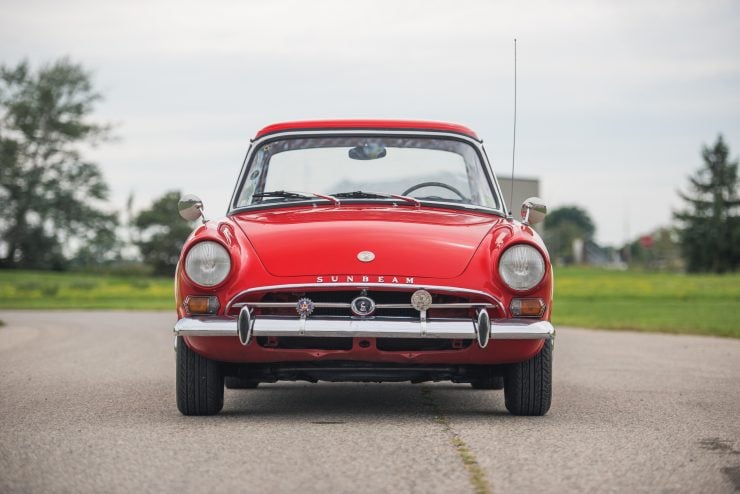
Brakes, Steering and Suspension
The suspension of the Sunbeam Alpine is conventional and repairable. Series I, II, and III cars have kingpins in the front suspension that require periodic greasing. The Series IV and V cars have “Metalastik” bushings which don’t.
The lever shock absorbers used in the rear suspension of the earlier cars are not available as replacements but can be re-built.
Brakes can be serviced although the front disc brake rotors can be difficult to find. The parts to overhaul the steering box are obtainable.
Electrics
The Sunbeam Alpine used off the shelf electrical components that are common to British cars of that era. These are readily obtainable. Be sure to check that all electrical systems and lights work on the car – seemingly small problems can rapidly expand in scope.
Conclusion
The Sunbeam Alpine was never as popular as such cars as the MGB and because of its lower popularity there are advantages and disadvantages. The main advantage is that these cars tend to be less sought after and thus tend to be more affordable. The disadvantage being that because there are a lot less of them which have survived to be lovingly restored there has been less demand for after-market manufacturers to make parts for them, making parts harder to find. That being said the Sunbeam Alpine is a great British sports car bringing with it all the enjoyment that these cars offer.
The styling of the earlier Series I, II ,and III cars is pure Raymond Loewy with its Ken Howes Studebaker influence so many consider these to be the most visually pleasing cars, whilst the later Series IV and V have mechanical refinements that make them easier to maintain. Partly for these reasons the Series III cars are perhaps the cream of the crop and if you are wanting to get the best of the pure styling but take advantage of the later car’s mechanical refinements then getting a good Series III and fitting it with the later all synchromesh gearbox and a set of Weber carburettors will put together a very nice sports car. The Sunbeam Alpine was one of the most comfortable and well thought out of the British sports cars of this era and they are a wonderful way to enjoy touring in a grand style whether its in a roadster or a hard top.
Editor’s Note: If you have tips, suggestions, or hard earned experience that you’d like to add to this buying guide please shoot us an email. We’re always looking to add to our guides, and your advice could be very helpful to other enthusiasts, allowing them to make a better decision.
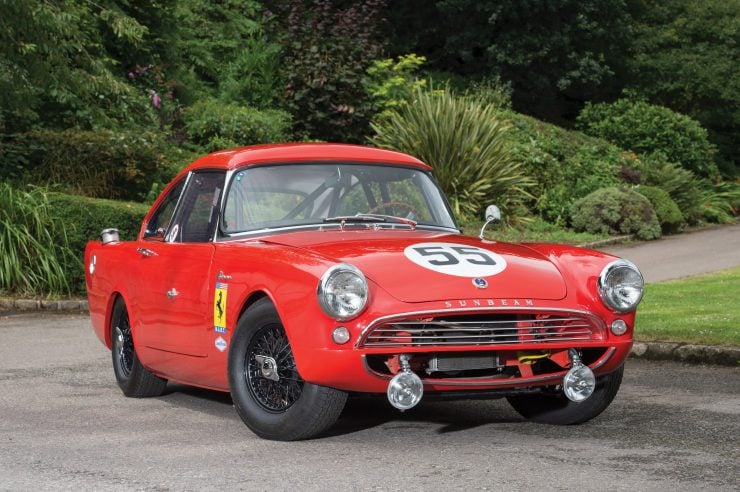
Photo Credits: ©2016 Courtesy of RM Sotheby’s – Red Alpine Series III
Photo Credits: Jason Dodd ©2016 Courtesy of RM Sotheby’s – Sunbeam Harrington Alpine NART Coupé
Photo Credits: Simon Clay + Bonhams ©2015 – Sunbeam Alpine Series II

